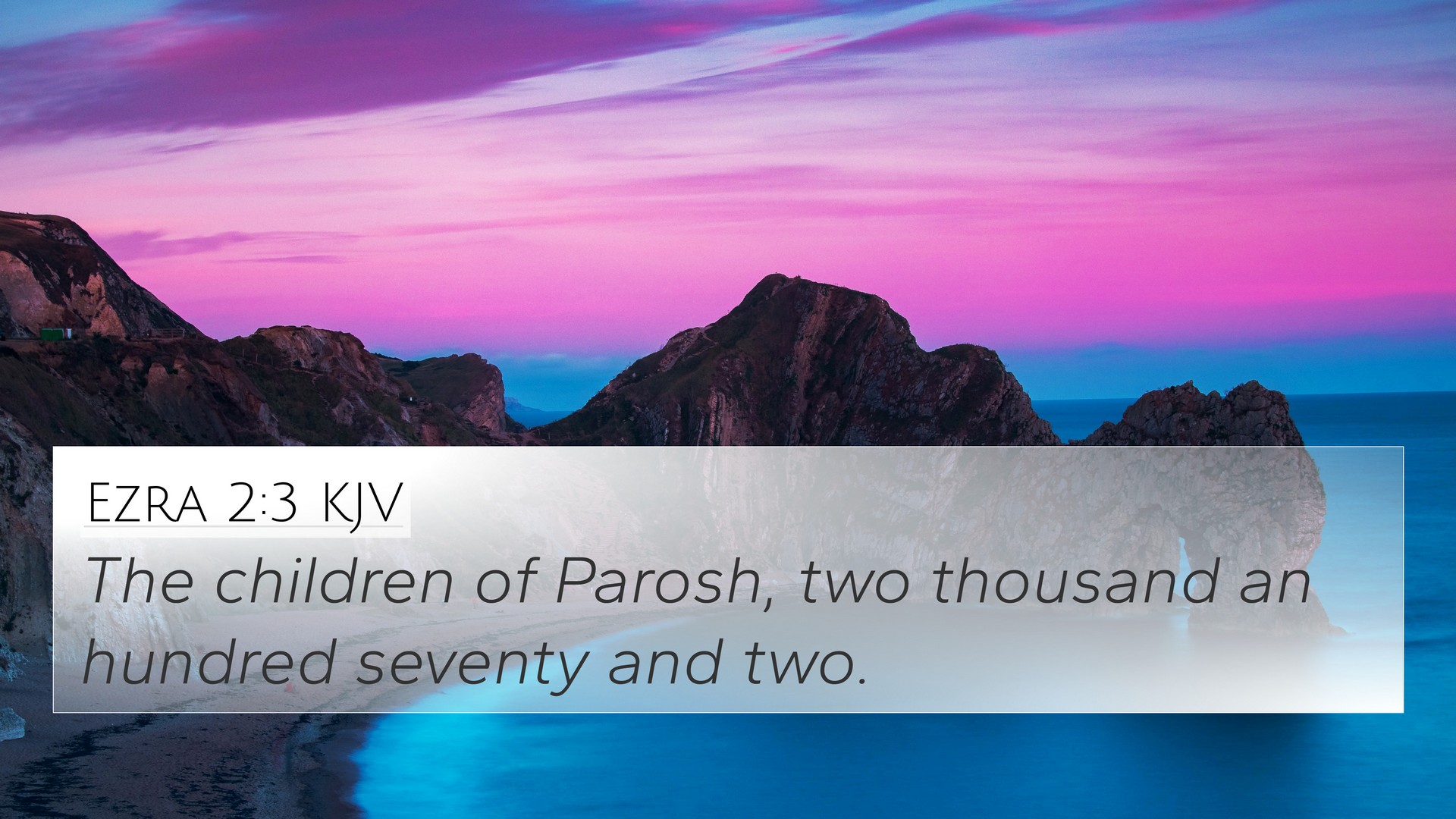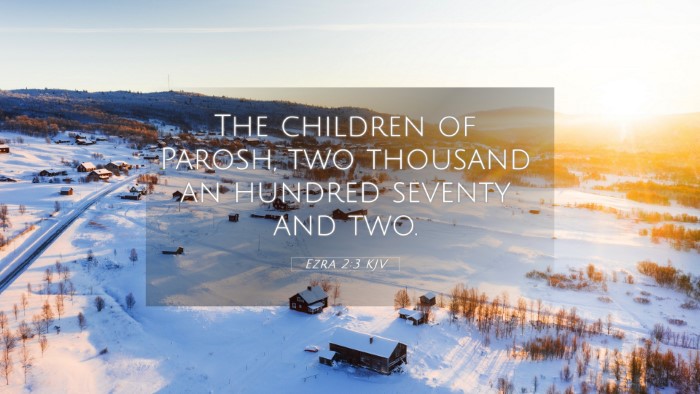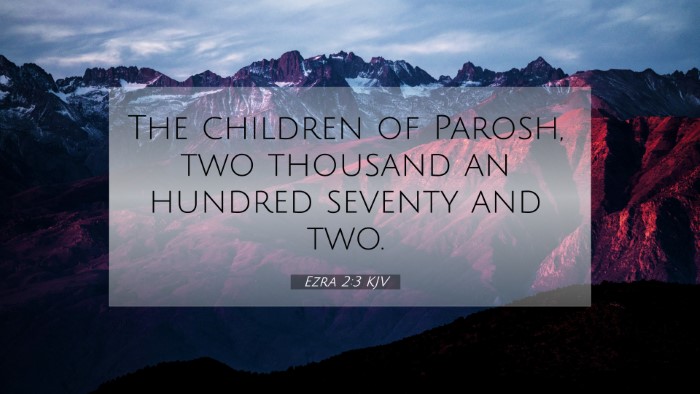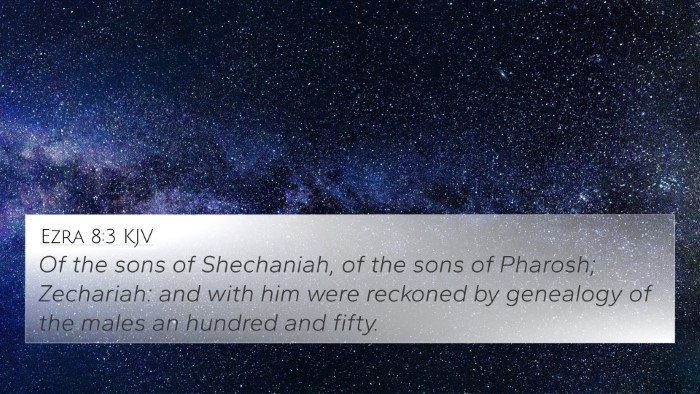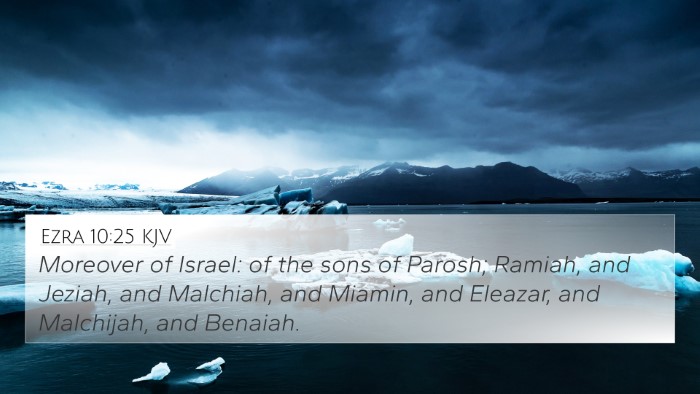Ezra 2:3 - Understanding the Verse
Ezra 2:3 states, "The children of Parosh, two thousand a hundred seventy and two." This verse is part of a larger passage detailing the return of the Israelites from Babylonian captivity, listing the families and individuals who returned to Jerusalem.
Commentary Insights
In analyzing Ezra 2:3, we can gather significant insights from several public domain commentaries, including those of Matthew Henry, Albert Barnes, and Adam Clarke.
Matthew Henry's Commentary
Matthew Henry points out that the listing of the people reflects God’s faithfulness. The numbers represent not just families, but also the restoration of identity and heritage. Henry emphasizes that every individual counted signifies divine favor and remembrance among the faithful who returned to their homeland. The continuation of the genealogical narrative symbolizes the importance of legacy in the covenant community.
Albert Barnes' Commentary
Albert Barnes offers the view that this detailing is essential for establishing legitimate claims to land and priestly functions. He notes that the numbers may seem trivial but serve a purpose in understanding the scale of return from exile. Each family’s inclusion signifies hope and renewal for the people of Israel, signifying a new beginning in their covenant with God following a period of judgment and exile.
Adam Clarke's Commentary
Adam Clarke expands on the historical context of these families. He points out that the number indicated, “two thousand a hundred seventy and two,” reveals a significant community willing to return to Jerusalem, affirming their collective journey back to spiritual roots. Clarke underscores the role of genealogies throughout Scripture as vital connections linking back to the promises made to their ancestors.
Connections to Other Biblical Verses
Ezra 2:3 is not only significant in its own context but also offers various connections throughout Scripture. Here are some cross-references worth noting:
- Nehemiah 7:8 - Nehemiah echoes the same list of families showing the continuity of the returning exiles.
- 1 Chronicles 9:3 - This verse lists the inhabitants of Jerusalem and implies the historical context of the returning exiles.
- Jeremiah 29:10 - God’s promise of restoration after a period of exile aligns with the return of the Israelites.
- Ezra 1:5 - Illustrates the stirring of the spirit among the exiles to return, paving the way for this returner list.
- Isaiah 44:28 - Gives prophetic insight into Cyrus’ decree which enabled the return to Jerusalem.
- Ezra 2:64 - Complements Ezra 2:3 by providing the total count of those who returned as 42,360.
- Romans 11:1 - Discussing the remnant of Israel connects the past to New Testament theology.
- Revelation 21:12 - References tribes of Israel highlight the continuity of God’s people through generations.
- Acts 7:43 - Stephen references God's dealings with Israel, further emphasizing their historical journey.
- Hebrews 11:6 - Highlighting the faith of those returning, applicable to understanding the spiritual milestones of Ezra's journey.
Thematic Bible Verse Connections
The themes woven throughout Ezra 2:3 lend themselves to a broader understanding of biblical history. Below are some thematic connections:
- Restoration - The return is symbolic of complete restoration after punishment and exile.
- Identity - Understanding of being God’s covenant people is critical for spiritual memory.
- Faithfulness - The listing reflects God's faithfulness to His promises across generations.
- Community - The emphasis on family units shows the significance of community in faith practices.
- Legacy - Each family represents a vital part of Israel's heritage, emphasizing the importance of roots.
Conclusion
In summary, Ezra 2:3 serves as more than just a historical reference; it encapsulates God’s promise of restoration, the importance of lineage, and the renewed hope for the people of Israel. Cross-referencing biblical texts related to this verse enhances our understanding of the narrative and its implications for contemporary faith. This verse exemplifies the intricate tapestry of God’s plan for His people, linking past, present, and future.
As we continue to explore these biblical themes, utilizing tools for Bible cross-referencing and various reference resources can illuminate deeper insights into scripture. Understanding connections between Bible verses like Ezra 2:3 can enrich one’s study and interpretation of the Scriptures, shedding light on God's overarching narrative throughout the Bible.
